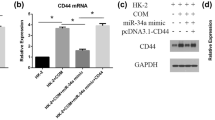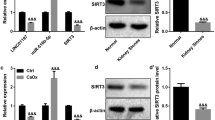Abstract
Kidney stones are regarded as common malignant diseases in the developed world. As a result, significant research examining their formation is ongoing, with microRNAs (miRs) recently being linked with kidney stone formation. Here, we aim to define the potential role of miR-484 in regulating renal tubular epithelial cell (RTEC) viability and the attachment of calcium oxalate (CaOx) crystals to RTECs via vitamin D receptor (VDR)/forkhead box protein O1 (FoxO1) axis. The pathological condition of CaOx crystallization was induced and examined in Sprague–Dawley rats, while RTECs were isolated and cultured in vitro. Loss- and gain-function assays were performed to study the effects that miR-484, VDR, and FoxO1 on RTEC functions and CaOx crystallization in vitro and on kidney stone formation in vivo. The interaction between miR-484 and VDR was confirmed by dual-luciferase reporter gene assays. Downregulation of miR-484 and FoxO1 as well as overexpression of VDR were identified in kidney stone modelled rats. VDR was confirmed as a target gene of miR-484, while knockdown of VDR upregulated the FoxO1 expression. miR-484 overexpression or VDR suppression reduced RTEC cytotoxicity and crystal attachment to RTECs in vitro and reduced the CaOx crystallization in vivo. Taken together, these findings suggest that miR-484 overexpression may be a potential inhibitor of RTEC proliferation and CaOx crystallization through a VDR/FoxO1 regulatory axis, providing a novel therapeutic target for the treatment of kidney stone.








Similar content being viewed by others
References
Narula S, Tandon S, Baligar P, Singh SK, Tandon C (2017) Human kidney stone matrix: latent potential to restrain COM induced cytotoxicity and inflammatory response. Chem Biol Interact 278:114–122. https://doi.org/10.1016/j.cbi.2017.10.018
Shu X, Cai H, Xiang YB, Li H, Lipworth L, Miller NL, Zheng W, Shu XO, Hsi RS (2017) Nephrolithiasis among middle aged and elderly urban Chinese: a report from prospective cohort studies in Shanghai. J Endourol 31(12):1327–1334. https://doi.org/10.1089/end.2017.0467
Khan SR (2011) Crystal/cell interaction and nephrolithiasis. Archivio italiano [di] urologia, andrologia : organo ufficiale di Societa italiana di ecografia urologica e nefrologica 83(1):1–5
Lu X, Gao B, Wang Y, Liu Z, Yasui T, Liu P, Liu J, Emmanuel N, Zhu Q, Xiao C (2012) Renal tubular epithelial cell injury, apoptosis and inflammation are involved in melamine-related kidney stone formation. Urol Res 40(6):717–723. https://doi.org/10.1007/s00240-012-0507-x
Yu L, Gan X, Liu X, An R (2017) Calcium oxalate crystals induces tight junction disruption in distal renal tubular epithelial cells by activating ROS/Akt/p38 MAPK signaling pathway. Ren Fail 39(1):440–451. https://doi.org/10.1080/0886022X.2017.1305968
Wang B, Wu B, Liu J, Yao W, Xia D, Li L, Chen Z, Ye Z, Yu X (2014) Analysis of altered microRNA expression profiles in proximal renal tubular cells in response to calcium oxalate monohydrate crystal adhesion: implications for kidney stone disease. PLoS ONE 9(7):e101306. https://doi.org/10.1371/journal.pone.0101306
Hackenberg M, Shi BJ, Gustafson P, Langridge P (2012) A transgenic transcription factor (TaDREB3) in barley affects the expression of microRNAs and other small non-coding RNAs. PLoS ONE 7(8):e42030. https://doi.org/10.1371/journal.pone.0042030
Du R, Sun W, Xia L, Zhao A, Yu Y, Zhao L, Wang H, Huang C, Sun S (2012) Hypoxia-induced down-regulation of microRNA-34a promotes EMT by targeting the Notch signaling pathway in tubular epithelial cells. PLoS ONE 7(2):e30771. https://doi.org/10.1371/journal.pone.0030771
Ye FG, Song CG, Cao ZG, Xia C, Chen DN, Chen L, Li S, Qiao F, Ling H, Yao L, Hu X, Shao ZM (2015) Cytidine deaminase axis modulated by miR-484 differentially regulates cell proliferation and chemoresistance in breast cancer. Cancer Res 75(7):1504–1515. https://doi.org/10.1158/0008-5472.CAN-14-2341
Chen C, Luo Y, Su Y, Teng L (2019) The vitamin D receptor (VDR) protects pancreatic beta cells against Forkhead box class O1 (FOXO1)-induced mitochondrial dysfunction and cell apoptosis. Biomed Pharmacother 117:109170. https://doi.org/10.1016/j.biopha.2019.109170
Lee KY, Choi HS, Choi HS, Chung KY, Lee BJ, Maeng HJ, Seo MD (2016) Quercetin directly interacts with vitamin D receptor (VDR): structural implication of VDR activation by Quercetin. Biomol Ther (Seoul) 24(2):191–198. https://doi.org/10.4062/biomolther.2015.122
Guo X, Lin H, Liu J, Wang D, Li D, Jiang C, Tang Y, Wang J, Zhang T, Li Y, Yao P (2020) 1,25-Dihydroxyvitamin D attenuates diabetic cardiac autophagy and damage by vitamin D receptor-mediated suppression of FoxO1 translocation. J Nutr Biochem 80:108380. https://doi.org/10.1016/j.jnutbio.2020.108380
Xi J, Chen Y, Jing J, Zhang Y, Liang C, Hao Z, Zhang L (2019) Sirtuin 3 suppresses the formation of renal calcium oxalate crystals through promoting M2 polarization of macrophages. J Cell Physiol 234(7):11463–11473. https://doi.org/10.1002/jcp.27803
Khan SR, Glenton PA (2008) Calcium oxalate crystal deposition in kidneys of hypercalciuric mice with disrupted type IIa sodium-phosphate cotransporter. Am J Physiol Renal Physiol 294(5):F1109-1115. https://doi.org/10.1152/ajprenal.00620.2007
Tuo YL, Li XM, Luo J (2015) Long noncoding RNA UCA1 modulates breast cancer cell growth and apoptosis through decreasing tumor suppressive miR-143. Eur Rev Med Pharmacol Sci 19(18):3403–3411
Cong X, Shen L, Gu X (2018) Current opinions on nephrolithiasis associated with primary hyperparathyroidism. Urolithiasis 46(5):453–457. https://doi.org/10.1007/s00240-018-1038-x
Miyazawa K, Suzuki K, Ikeda R, Moriyama MT, Ueda Y, Katsuda S (2005) Apoptosis and its related genes in renal epithelial cells of the stone-forming rat. Urol Res 33(1):31–38. https://doi.org/10.1007/s00240-004-0434-6
Jeong BC, Kwak C, Cho KS, Kim BS, Hong SK, Kim JI, Lee C, Kim HH (2005) Apoptosis induced by oxalate in human renal tubular epithelial HK-2 cells. Urol Res 33(2):87–92. https://doi.org/10.1007/s00240-004-0451-5
Liang X, Lai Y, Wu W, Chen D, Zhong F, Huang J, Zeng T, Duan X, Huang Y, Zhang S, Li S, Wu W (2019) LncRNA-miRNA-mRNA expression variation profile in the urine of calcium oxalate stone patients. BMC Med Genomics 12(1):57. https://doi.org/10.1186/s12920-019-0502-y
Hu YY, Dong WD, Xu YF, Yao XD, Peng B, Liu M, Zheng JH (2014) Elevated levels of miR-155 in blood and urine from patients with nephrolithiasis. Biomed Res Int 2014:295651. https://doi.org/10.1155/2014/295651
Sasaki Y, Kohjimoto Y, Iba A, Matsumura N, Hara I (2015) Weight loss intervention reduces the risk of kidney stone formation in a rat model of metabolic syndrome. Int J Urol: Off J Japn Urol Assoc 22(4):404–409. https://doi.org/10.1111/iju.12691
Wu YX, Li CY, Deng YL (2014) Patients with nephrolithiasis had lower fetuin-A protein level in urine and renal tissue. Urolithiasis 42(1):29–37. https://doi.org/10.1007/s00240-013-0613-4
Lu Y, Qin B, Hu H, Zhang J, Wang Y, Wang Q, Wang S (2016) Integrative microRNA-gene expression network analysis in genetic hypercalciuric stone-forming rat kidney. PeerJ 4:e1884. https://doi.org/10.7717/peerj.1884
Shi W, Dong F, Jiang Y, Lu L, Wang C, Tan J, Yang W, Guo H, Ming J, Huang T (2019) Construction of prognostic microRNA signature for human invasive breast cancer by integrated analysis. Onco Targets Ther 12:1979–2010. https://doi.org/10.2147/OTT.S189265
Kjersem JB, Ikdahl T, Lingjaerde OC, Guren T, Tveit KM, Kure EH (2014) Plasma microRNAs predicting clinical outcome in metastatic colorectal cancer patients receiving first-line oxaliplatin-based treatment. Mol Oncol 8(1):59–67. https://doi.org/10.1016/j.molonc.2013.09.001
Li T, Ding ZL, Zheng YL, Wang W (2017) MiR-484 promotes non-small-cell lung cancer (NSCLC) progression through inhibiting Apaf-1 associated with the suppression of apoptosis. Biomed Pharmacother 96:153–164. https://doi.org/10.1016/j.biopha.2017.09.102
Wang K, Long B, Jiao JQ, Wang JX, Liu JP, Li Q, Li PF (2012) miR-484 regulates mitochondrial network through targeting Fis1. Nat Commun 3:781. https://doi.org/10.1038/ncomms1770
Zinser G, Packman K, Welsh J (2002) Vitamin D(3) receptor ablation alters mammary gland morphogenesis. Development 129(13):3067–3076
Du J, Jiang S, Hu Z, Tang S, Sun Y, He J, Li Z, Yi B, Wang J, Zhang H, Li YC (2019) Vitamin D receptor activation protects against lipopolysaccharide-induced acute kidney injury through suppression of tubular cell apoptosis. Am J Physiol Renal Physiol 316(5):F1068–F1077. https://doi.org/10.1152/ajprenal.00332.2018
Feng Y, Yao Z, Klionsky DJ (2015) How to control self-digestion: transcriptional, post-transcriptional, and post-translational regulation of autophagy. Trends Cell Biol 25(6):354–363. https://doi.org/10.1016/j.tcb.2015.02.002
Acknowledgements
We would like to acknowledge the reviewers for their helpful comments on this study.
Author information
Authors and Affiliations
Contributions
LF and WH: designed the study. LF and HL: collated the data, carried out data analyses and produced the initial draft of the manuscript. HL and WH: contributed to drafting the manuscript. All authors have read and approved the final submitted manuscript.
Corresponding author
Ethics declarations
Conflict of interest
The authors declare no conflicts of interest.
Additional information
Publisher's Note
Springer Nature remains neutral with regard to jurisdictional claims in published maps and institutional affiliations.
Rights and permissions
Springer Nature or its licensor holds exclusive rights to this article under a publishing agreement with the author(s) or other rightsholder(s); author self-archiving of the accepted manuscript version of this article is solely governed by the terms of such publishing agreement and applicable law.
About this article
Cite this article
Fan, L., Li, H. & Huo, W. Inhibitory role of microRNA-484 in kidney stone formation by repressing calcium oxalate crystallization via a VDR/FoxO1 regulator axis. Urolithiasis 50, 665–678 (2022). https://doi.org/10.1007/s00240-022-01359-6
Received:
Accepted:
Published:
Issue Date:
DOI: https://doi.org/10.1007/s00240-022-01359-6




